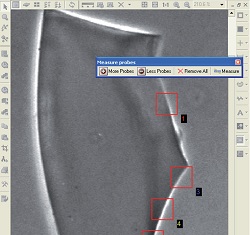DETERMINING the refractive index of glass fragments for forensic purposes is about to become faster and easier, says Craic Technologies, with the launch of its rIQ microspectrophotometry system.

Glass fragment under forensic assessment by rIQ
Glass particles are common at crime scenes, the company notes, and forensic scientists want to collect these in order to measure and compare their properties. Chief among these properties are the colour and refractive index of the glass, which can determine which fragments are from the same original artefact.
The rIQ (refractive index quantification) system combines image analysis software with advanced optical design and electronics. It uses thermal immersion, a method defined by ASTM E1967-98, to measure the refractive index of glass fragments and enables the user to analyse several particles at the same time.
Developed in partnership with microscope imaging software specialist Laboratory Imaging, rIQ is available as a standalone package consisting of a phase contrast microscope, digital camera, optical interface, thermal stage, plus electronics and software, or as an add-on or upgrade to an existing Craic microspectrophotometer.
“rIQ is the first result of our partnership with Laboratory Imaging, and promises to take the technique of forensic refractive index determination to the next level”, says Dr Paul Martin, president of Craic Technologies. “It enables the forensic scientist to measure and compare the refractive index of the smallest fragments of glass with an incredibly high degree of accuracy. When combined with our microscope spectrophotometers and microcolorimeters, the transmission and fluorescence spectral characteristics of glass evidence can also be determined quickly and accurately, and all with the same instrument.”
So what is the smallest fragment that can be analysed by the rIQ method? Paul Martin told LabHomepage that anything larger than 50 microns across is big enough – that’s 0.05mm, which is roughly the size of a typical grain of sand.
